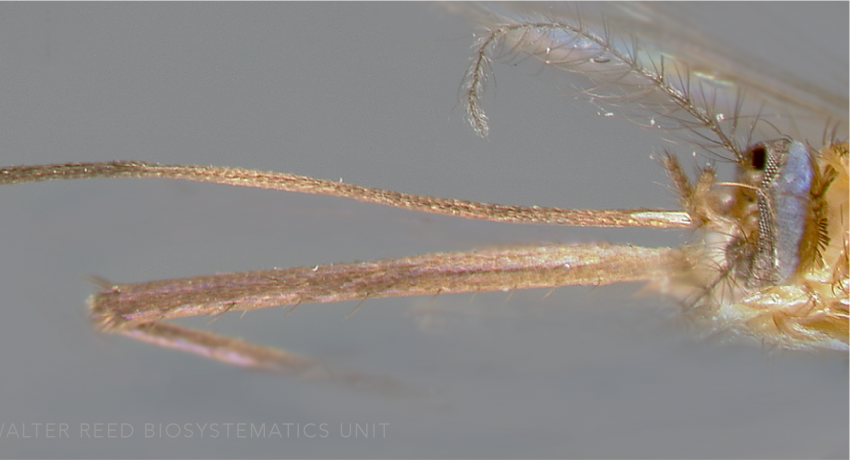NEOTROPICAL REGION
Generic abbreviation: Ru.
Type species: Runchomyia frontosa Theobald
Etymology: not stated [runcho = ?; ”The character upon which the genus is founded is the peculiar projecting blunt frontal process in the (female).”].
The forest-associated Neotropical genus Runchomyia includes only eight species divided into two subgenera: Ctenogoeldia (two species: Runchomyia magna (Theobald), Ru. walcotti (Lane & Cerqueira)) and Runchomyia (six species: Ru. cerqueirai (Stone), Ru. frontosa Theobald, Ru. humboldti (Lane & Cerqueira), Ru. rapax (Dyar & Knab), Ru. reversa (Lane & Cerqueira), Ru. theobaldi (Lane & Cerqueira)). Interestingly five of the six species in the subgenus Runchomyia—Ru. cerqueirai, Ru. frontosa, Ru. humboldti, Ru. reversa, and Ru. theobaldi—are found in the Unidade de Conservação Ambiental Desterro forest on Santa Catarina Island, Brazil. All subgenus Runchomyia are predominantly restricted to South America, but Ru. cerqueirai and Ru. frontosa are also found in Panama, and Ru. frontosa, Ru. rapax and Ru. theobaldi occur on Trinidad and Tobago.
DIAGNOSTIC CHARACTERS (Click photos to view; mouse over and click large photo to zoom in.)
ADULT (illustrated): Head: Head scales bright blue and silver dorsally; proboscis c. 1.2–1.4 x length of forefemur (Fe-I). Thorax: Scutal scales narrow and curved; lower edge of mesepimeron above lower mesokatepisternal setae; at least one postpronotal setae (PpS) present. Legs: Ta-I–III all dark.
LARVA (not illustrated): Head: Maxillary brush modified to form bundle; occipital foramen slit-like. Terminal segments: Pecten filamentous; seta 3-X single; seta 6-S small, not hooked at tip.
TAXONOMIC KEYS
Darsie 1985 (Argentina)
![]()
WRBU – Genera – Global – Larva
![]()
WRBU – Genera – Nearctic – Adult
![]()
WRBU – Genera – Nearctic – Larva
Exemplar DNA sequences
Ru. magna COI: MF172350–54
Ru. reversa whole mitochondrial genome: MK5775487, NC_044659
BIONOMICS
Immatures
Runchomyia larvae are most commonly found in water collections in the flower bracts and leaf axils of Calathea, Heliconia and Xanthosoma plants, and bromeliads. Runchomyia reversa immatures occupy the internodes of Guadua chacoensis and Guadua trinii bamboo, and Ru. frontosa immatures are commonly collected in the juices of the carnivorous bromeliad, Brocchinia reducta.
Adults
Runchomyia species are usually diurnal, although a few species are also active at night—Ru. frontosa, and Ru. reversa were collected in CDC light traps in the Atlantic forest and Guapiaçu Ecological Reserve, in Rio de Janeiro State, Brazil, respectively. Runchomyia magna have been collected at human bait in the early evening (17:00–18:00). Runchomyia frontosa, Ru. magna, and Ru. theobaldi will feed on people in forest environments, and Ru. frontosa is an important field vector of yellow fever in the Neotropics.
*Associated pathogens: This list reports bacteria, viruses, and parasites recovered from, or experimentally passed through this species, and does not imply field vector status.
IMPORTANT REFERENCES (full citations below)
Theobald 1903a: 319 (as genus, subgenus).
Lane 1953 (taxonomy, bionomics; as subgenus of genus Trichoprosopon)
Zavortink 1979b: 12 (keys; from subgenus of genus Trichoprosopon)
Darsie 1985 (keys; Argentina)
Harbach & Peyton 1993 (L mouthparts; classification)
Judd 1996 (phylogeny)
VALID SUBGENERA
Ctenogoeldia Edwards [Cte.]
Runchomyia Theobald [Run.]
CURRENT GENERIC SYNONYMS
syn. Rhynchomyia Lutz 1904: 55 (unjust. emend. for Runchomyia Theobald). In Bourroul 1904.
syn. Binotia Blanchard 1904: 478. Type species: Runchomyia frontosa Theobald. Proposed as replacement name for Runchomyia.
syn. Lesticocampa Dyar & Knab 1906d: 226 (as genus). Type species: Wyeomyia lunata Theobald (Bruneti 1914: 63, Lestiocampa, unjust. emend.). Type species: Wyeomyia lunata Theobald.
CITED REFERENCES
Blanchard, R. (1904). Notes et informations. Archives de Parasitologie, 8, 478.
Darsie, R.F., Jr. (1985). Mosquitoes of Argentina. Part I. Keys for identification of adult females and fourth stage larvae in English and Spanish (Diptera, Culicidae). Mosquito Systematics, 17(3), 153-23–253.
Dyar, H.G., & Knab, F. (1906d). The larvae of Culicidae classified as independent organisms. Journal of the New York Entomological Society, 14, 169–230.
Harbach, R.E., & Peyton, E.L. (1993). Morphology and evolution of the larval maxilla and its importance in the classification of the Sabethini (Diptera: Culicidae). Mosquito Systematics, 25(1), 1–16.
Judd, D.J. (1996). Review of the systematics and phylogenetic relationships of the Sabethini (Diptera: Culicidae). Systematic Entomology, 21(2), 129–150.
Lane, J. (1953). Neotropical Culicidae (Vols. I, II). São Paulo: University of São Paulo.
Lutz, A. (1904). Quadro dos generos da familia Culicidae (2 page folded table). In: C. Bourroul. Mosquitos do Brasil, PhD Thesis, JB de Oliveira Costa, Salvador, Bahia.
Theobald, F.V. (1903a). A monograph of the Culicidae of the World (Vol. 3). London: British Museum (Natural History). 359pp
Zavortink, T.J. (1979b). The new sabethine genus Johnbelkinia and A preliminary reclassification of the composite genus Trichoprosopon. Contributions of the American Entomological Institute, 17(1), 1–61.
CITE THIS PAGE
Walter Reed Biosystematics Unit (Year). Runchomyia genus page. Walter Reed Biosystematics Unit Website, http://wrbu.si.edu/vectorspecies/genera/runchomyia, accessed on [date (e.g. 03 February 2020) when you last viewed the site].






